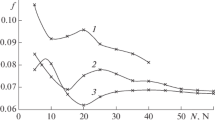Conclusions
-
1.
A new method has been developed for assessing the lacquer-forming properties of motor oils with dynamic thin-layer oxidation at high (250–370°C) temperatures. The method makes it possible to:
-
a)
clearly differentiate base oils;
-
b)
assess the effectiveness of additives;
-
c)
select the optimal additive concentration for combined use;
-
d)
assess the compatiability of additives in the case of joint use.
-
2.
Tests on oils and additives in the Sliding Ring device have established the following.
-
a)
Different additives display different patterns of behavior in the same base oil. With increasing concentration of the additive in the oil, the lacquer-forming capacity of the later may:
-
1)
decrease;
-
2)
increase;
-
3)
first decrease, then increase;
-
o
4) first increase, then decrease.
-
b)
Depending on the quality of the base oil, the effectiveness of the same oil in it may vary by a factor of 2–3.
Similar content being viewed by others
Additional information
N. I. Petrova helped with the experiments.
Translated from Khimiya i Tekhnologiya Topliv i Masel, No. 5, pp. 51–54, May, 1971.
Rights and permissions
About this article
Cite this article
Papok, K.K., Zarubin, A.P., Zakharov, G.V. et al. Lacquer-forming properties of motor oil under high-temperature conditions. Chem Technol Fuels Oils 7, 386–390 (1971). https://doi.org/10.1007/BF00714532
Issue Date:
DOI: https://doi.org/10.1007/BF00714532




